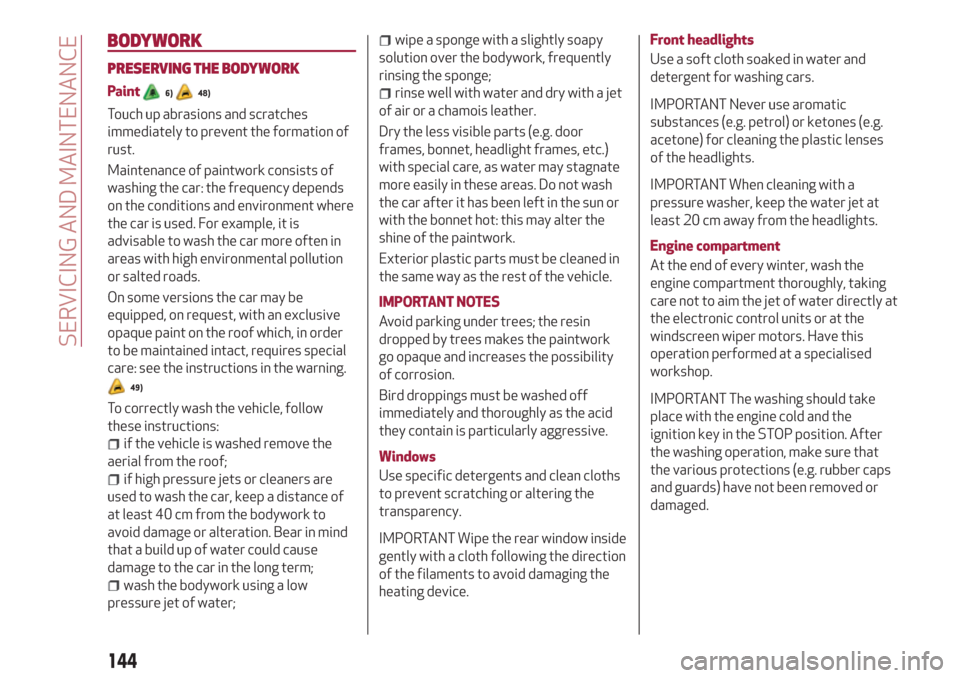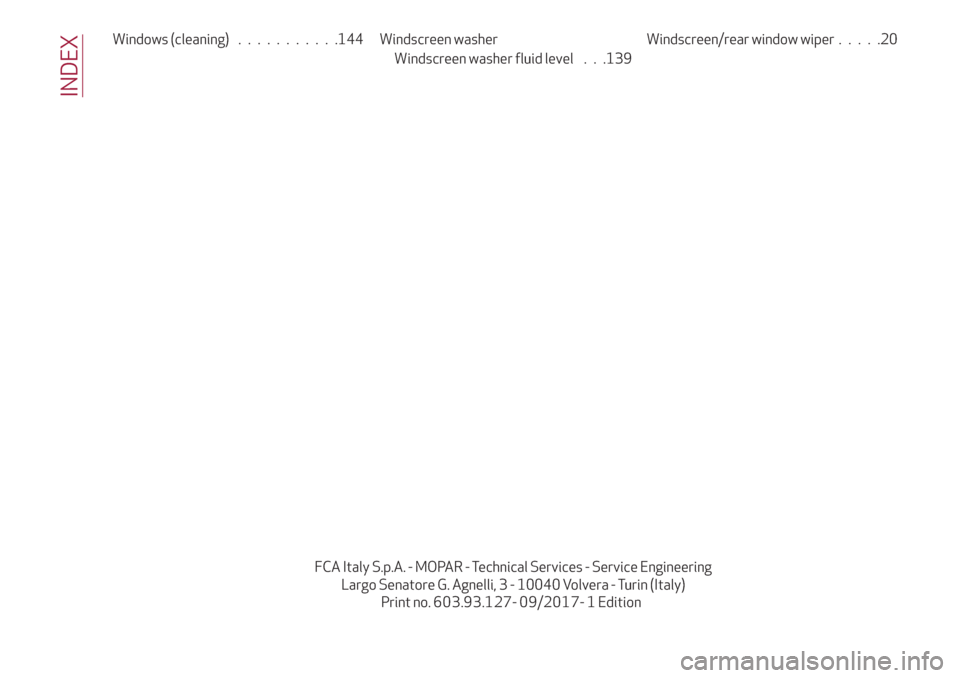2018 Alfa Romeo Giulietta wiper
[x] Cancel search: wiperPage 141 of 216

ENGINE OIL
Check that the oil level is between the
MIN and MAX references on the dipstick
3.
If the level of the oil is close to or below
the MIN mark, add oil via the filler fitting
2 until the MAX mark is reached.
131)42)
Take out the engine oil dipstick 3, clean it
with a lint-free cloth and reinsert it.
Extract it again and check that the level is
between the MIN and MAX marks on the
dipstick.
Engine oil consumption
43)3)
The maximum engine oil consumption is
usually 400 grams every 1000 km. When
the car is new, the engine needs to be run
in; therefore the engine oil consumption
can only be considered stabilised after
the first 5000 - 6000 km.
ENGINE COOLANT FLUID
If the level is too low, unscrew the cap
1 of reservoir and add the fluid described
in the "Technical Specifications" chapter.
44)132)
WINDSCREEN / REAR WINDOW
WASHING FLUID
If the level is too low, raise the reservoir
cap 6 and add the fluid described in the
"Technical Specifications" chapter.
133) 134)
IMPORTANT The headlight washer
system will not operate when the fluid
level is low, even though the
windscreen/rear window washer
continues to operate. For
versions/markets, where provided, there
is a reference notch on the dipstick (see
previous pages): ONLY the
windscreen/rear window wiper operates
with the level below this reference.
BRAKE FLUID
Check that the fluid is at the max. level.
If the fluid level in the reservoir is too low,
undo the reservoir cap 4 and add the fluid
described in the "Technical
Specifications" chapter.
45)135) 136)
AUTOMATIC TRANSMISSION
ACTIVATIONSYSTEM OIL
(for versions/markets, where provided)
The transmission control oil level should
only be checked at an Alfa Romeo
Dealership.
4)
IMPORTANT
41)Be careful not to confuse the various
types of fluids while topping up: they are not
compatible with each other! Topping up with
an unsuitable fluid could severely damage
your vehicle.42)The oil level must never exceed the MAX
reference.
43)Do not add oil with specifications other
than those of the oil already in the engine.
44)Use a fluid of the same type as that
already present in the reservoir for any
topping up of the engine cooling system. The
fluid cannot be mixed with other types of
antifreeze fluids. In the event of topping up
with an unsuitable product, under no
circumstances start the engine and contact
an Alfa Romeo Dealership.
45)Prevent brake fluid, which is highly
corrosive, from coming into contact with
painted parts. Should it happen, immediately
wash with water.
WARNING
129)Never smoke while working in the
engine compartment: gas and inflammable
vapours may be present, with the risk of fire.
130)Be very careful when working in the
engine compartment when the engine is hot:
you may get burned. Do not get too close to
the radiator cooling fan: the electric fan may
start; danger of injury. Scarves, ties and
other loose clothing might be pulled by
moving parts.
131)If the engine oil is being topped up, wait
for the engine to cool down before loosening
the filler cap, particularly for vehicles with
aluminium cap (where provided). WARNING:
risk of burns!
139
Page 144 of 216

HEADLIGHT WASHERS
(for versions/markets, where provided)
These are located within the front
bumper.
They are activated when the dipped
beam and/or main beam headlights are
on and the windscreen washer is
activated.
Check the correct condition and
cleanliness of nozzles at regular
intervals.
WARNING
137)Driving with worn windscreen/rear
window wiper blades is a serious hazard,
because visibility is reduced in bad weather.
IMPORTANT
46)Do not operate the windscreen wiper
with the blades lifted from the windscreen.
BATTERY
The battery 5 (see previous pages) does
not require the electrolyte to be topped
up with distilled water. A periodic check
carried out at an Alfa Romeo Dealership
is, however, necessary to check
efficiency.
INSPECTING THE CHARGE AND THE
ELECTROLYTE LEVEL
138) 139) 140) 141)
47)
5)
If necessary, replace the battery with
another original battery with the same
specifications. Follow the battery
manufacturer's instructions for
maintenance.
USEFUL ADVICE FOR EXTENDING THE
LIFE OF YOUR BATTERY
To avoid draining your battery and make
it last longer, observe the following
instructions:
when you park the car, ensure that the
doors, tailgate and bonnet are closed
properly, to prevent any lights from
remaining on inside the passenger's
compartment;
switch off all roof lights inside the car:
the car is however equipped with a
system which switches all internal lights
off automatically;
do not keep accessories (e.g. radio,
hazard warning lights, etc.) switched on
for a long time when the engine is not
running;
before performing any operation on
the electrical system, disconnect the
negative battery cable.
IMPORTANT Every time the battery is
disconnected, the steering must be
initialised. This is indicated by the
appearance of the icon
. To carry out
this procedure, simply turn the steering
wheel all the way from one end to the
other or drive in a straight line for about a
hundred metres.
IMPORTANT If the charge level remains
under 50% for a long time, the battery is
damaged by sulphation, reducing its
capacity and efficiency at start-up.
The battery will also be more at risk of
freezing (this can happen as early as
-10°C). Refer to the "Vehicle inactivity"
paragraph in "Starting and driving"
chapter if the vehicle is left parked for a
long time.
142
SERVICING AND MAINTENANCE
Page 146 of 216

BODYWORK
PRESERVING THE BODYWORK
Paint6)48)
Touch up abrasions and scratches
immediately to prevent the formation of
rust.
Maintenance of paintwork consists of
washing the car: the frequency depends
on the conditions and environment where
the car is used. For example, it is
advisable to wash the car more often in
areas with high environmental pollution
or salted roads.
On some versions the car may be
equipped, on request, with an exclusive
opaque paint on the roof which, in order
to be maintained intact, requires special
care: see the instructions in the warning.
49)
To correctly wash the vehicle, follow
these instructions:
if the vehicle is washed remove the
aerial from the roof;
if high pressure jets or cleaners are
used to wash the car, keep a distance of
at least 40 cm from the bodywork to
avoid damage or alteration. Bear in mind
that a build up of water could cause
damage to the car in the long term;
wash the bodywork using a low
pressure jet of water;
wipe a sponge with a slightly soapy
solution over the bodywork, frequently
rinsing the sponge;
rinse well with water and dry with a jet
of air or a chamois leather.
Dry the less visible parts (e.g. door
frames, bonnet, headlight frames, etc.)
with special care, as water may stagnate
more easily in these areas. Do not wash
the car after it has been left in the sun or
with the bonnet hot: this may alter the
shine of the paintwork.
Exterior plastic parts must be cleaned in
the same way as the rest of the vehicle.
IMPORTANT NOTES
Avoid parking under trees; the resin
dropped by trees makes the paintwork
go opaque and increases the possibility
of corrosion.
Bird droppings must be washed off
immediately and thoroughly as the acid
they contain is particularly aggressive.
Windows
Use specific detergents and clean cloths
to prevent scratching or altering the
transparency.
IMPORTANT Wipe the rear window inside
gently with a cloth following the direction
of the filaments to avoid damaging the
heating device.
Front headlights
Use a soft cloth soaked in water and
detergent for washing cars.
IMPORTANT Never use aromatic
substances (e.g. petrol) or ketones (e.g.
acetone) for cleaning the plastic lenses
of the headlights.
IMPORTANT When cleaning with a
pressure washer, keep the water jet at
least 20 cm away from the headlights.
Engine compartment
At the end of every winter, wash the
engine compartment thoroughly, taking
care not to aim the jet of water directly at
the electronic control units or at the
windscreen wiper motors. Have this
operation performed at a specialised
workshop.
IMPORTANT The washing should take
place with the engine cold and the
ignition key in the STOP position. After
the washing operation, make sure that
the various protections (e.g. rubber caps
and guards) have not been removed or
damaged.
144
SERVICING AND MAINTENANCE
Page 170 of 216

Use Features SpecificationOriginal fluids and
lubricantsApplications
Washer fluid for
windscreen/rear
window/headlampsMixture of alcohol,water
and surfactants CUNA NC
956-119.55522 or MS.90043PETRONAS DURANCE SC
35
Contractual Technical
Reference N° F001.D16To be used diluted or
undiluted in windscreen
washer/wiper systems
IMPORTANT
51)The use of products with different specifications than those indicated above could cause damage to the engine that is not covered by the
warranty.
168
TECHNICAL SPECIFICATIONS
Page 213 of 216

Performance...............169
Pollen filter ................141
Pre-Fill system (RAB - Ready Alert
Brake)...................61
Pre-tensioners...............66
Load limiters..............66
Radio................181 ,193
Rain sensor.................21
Rear fog lights...............18
Rear fog lights/reversing lights
bulb replacement...........105
Rear view mirrors.............16
Door mirrors...............16
Rear window washer
rear window washer fluid level . . .139
Rear window wiper/washer.......21
Reconfigurable multifunction
display..................40
Refuelling.................162
Refuelling capacity............95
Refuelling the car.............94
Refuelling the vehicle...........95
Replacing a bulb.............100
General instructions.........100
Rims and tyres provided........156
Safe Lock (device).............8
SBR system (Seat Belt Reminder)....65
Scheduled servicing...........126Scheduled Servicing Plan........127
Screen wiper/washer...........20
“Smart washing” function.......21
Seat belts..................64
Use....................64
Seats.....................13
Front seats...............13
Rear seats................14
Servicing and maintenance
Demanding use of the car......134
periodic checks............134
Servicing procedures
Headlight washer...........142
Nozzles.................141
Setup menu.................41
Side airbags (Side bags - Window
bags)...................81
Side bags (front side airbags)......81
Side lights/brake lights
Side lights/daytime running lights
(DRL)
Side lights/dipped beam
headlights................17
Smart Bag system (multistage
front airbags)..............77
Start&Stop system............89
Starting the engine.........84,120
Bump starting.............120Jump starting.............120
Steering lock.................9
Steering wheel . . .............15
Steering wheel controls.....179 ,191
Technical data . .............148
The keys....................8
Mechanical key..............8
Third brake lights
Towing the car...............123
Towing the vehicle
Attaching the tow ring........123
Towing trailers . . .............94
Installing a tow hook..........94
Trip Computer . . .............43
Tyres
Fix&Go (kit)..............117
USB source.............183 ,195
Vehicle changes/alterations.......4
Warning lights and messages . .....44
Weights..................159
Wheels...................156
Wheels and tyres
When parked................85
Window bags (side airbags for head
protection)................81
Exterior lights.............104Bulb replacement...........105
Bulb replacement...........104Bulb replacement...........106
Inflation pressures..........157
Changing a wheel...........114
Tyre inflation pressure........157
Page 214 of 216

Windows (cleaning)...........144 Windscreen washer Windscreen/rear window wiper.....20
FCA Italy S.p.A. - MOPAR - Technical Services - Service Engineering
Largo Senatore G. Agnelli, 3 - 10040 Volvera - Turin (Italy)
Print no.603.93.127- 09/2017- 1Edition
INDEX
Windscreen washer fluid level . . .139